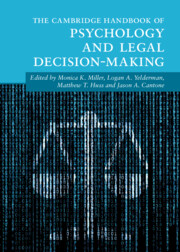Book contents
- The Cambridge Handbook of Psychology and Legal Decision-Making
- Cambridge Handbooks in Psychology
- The Cambridge Handbook of Psychology and Legal Decision-Making
- Copyright page
- Dedication
- Contents
- Figures
- Tables
- Editors
- Contributors
- Part I Introduction Chapters
- Part II Pretrial Phase Decision-Making
- 5 Victim Decision-Making
- 6 Bystanders’ Crime Reporting Decisions
- 7 Pretrial Publicity’s Effects on Jurors’ and Judges’ Decisions
- 8 Police Decisions Involved in Collecting Eyewitness Identification Evidence
- 9 Decisions Related to Miranda Rights
- 10 Judges’ Daubert Decisions
- 11 The Psychology of Confession Decision-Making During Police Interrogation
- 12 Plea Bargaining
- 13 Forensic Science Decision-Making
- 14 Decision-Making by Forensic Mental Health Evaluators
- 15 Interviewing Suspects in Criminal Investigations
- 16 Prosecutorial Decision-Making in Cases of Child Sexual Abuse
- 17 Decision-Making About Restoration of Defendants Who Are Incompetent to Stand Trial
- 18 Clinical Decision-Making Regarding Criminal Responsibility
- 19 Decision-Making Regarding Child Victims and Witnesses
- Part III Trial Phase Decision-Making
- Part IV Postconviction Phase Decisions
- Part V Other Legal Decision-Making
- Part VI Perspectives from the Field
- Part VII Conclusion
- Index
- References
14 - Decision-Making by Forensic Mental Health Evaluators
from Part II - Pretrial Phase Decision-Making
Published online by Cambridge University Press: 22 February 2024
- The Cambridge Handbook of Psychology and Legal Decision-Making
- Cambridge Handbooks in Psychology
- The Cambridge Handbook of Psychology and Legal Decision-Making
- Copyright page
- Dedication
- Contents
- Figures
- Tables
- Editors
- Contributors
- Part I Introduction Chapters
- Part II Pretrial Phase Decision-Making
- 5 Victim Decision-Making
- 6 Bystanders’ Crime Reporting Decisions
- 7 Pretrial Publicity’s Effects on Jurors’ and Judges’ Decisions
- 8 Police Decisions Involved in Collecting Eyewitness Identification Evidence
- 9 Decisions Related to Miranda Rights
- 10 Judges’ Daubert Decisions
- 11 The Psychology of Confession Decision-Making During Police Interrogation
- 12 Plea Bargaining
- 13 Forensic Science Decision-Making
- 14 Decision-Making by Forensic Mental Health Evaluators
- 15 Interviewing Suspects in Criminal Investigations
- 16 Prosecutorial Decision-Making in Cases of Child Sexual Abuse
- 17 Decision-Making About Restoration of Defendants Who Are Incompetent to Stand Trial
- 18 Clinical Decision-Making Regarding Criminal Responsibility
- 19 Decision-Making Regarding Child Victims and Witnesses
- Part III Trial Phase Decision-Making
- Part IV Postconviction Phase Decisions
- Part V Other Legal Decision-Making
- Part VI Perspectives from the Field
- Part VII Conclusion
- Index
- References
Summary
In any legal case, there is a pool of possible forensic evaluators whom a court might order, or an attorney might retain, to conduct a forensic mental health evaluation. There is a growing body of research showing that these evaluators are not interchangeable. They differ somewhat in their attitudes, personality traits, opinions about how to conduct evaluations, and thresholds for reaching conclusions. These differences, coupled with the subjectivity inherent to psycholegal questions and the pull of adversarial allegiance to retaining parties, can lead to biased decision-making. Although there is some support for specialized training as a mechanism for reducing these biases, even increased training will never eliminate the subjective clinical judgment necessary for some aspects of forensic assessment. The goal is to work toward reducing the impact of hidden biases on case outcomes, which should lead to better decisions by both evaluators and consumers of their work.
Keywords
- Type
- Chapter
- Information
- The Cambridge Handbook of Psychology and Legal Decision-Making , pp. 211 - 224Publisher: Cambridge University PressPrint publication year: 2024

